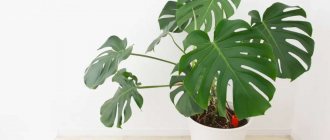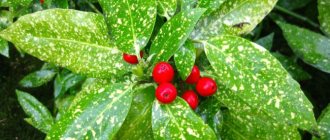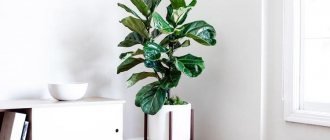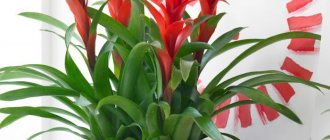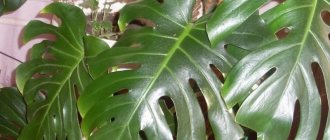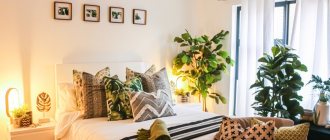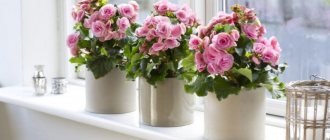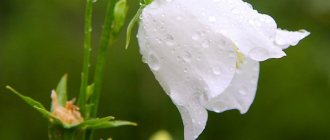We all love to keep indoor flowers at home.
Many of them need the sun to grow and develop. But the southern window sill is not enough for everyone. In this case, you should turn your attention to shade-loving and shade-tolerant indoor plants. These flowers can do well with a minimum of sunlight, which makes them welcome guests in any home. Dear readers! For you, we have created communities on social networks in which useful articles and interesting ideas are published several times a day! Subscribe and receive useful content in a convenient format!
What plants are considered shade-loving?
First of all, it is necessary to clarify that there are shade-tolerant plants, and there are shade-loving ones.
The first group includes flowers that feel equally good both in the light and when there is a lack of sunlight. The difference in lighting has virtually no effect on their appearance, abundance and duration of flowering.
The second group includes plants that are contraindicated in bright and direct sunlight and prolonged exposure to the sun. This group has 2 more names - sciophytes and heliophobes. That is, plants that are afraid of the sun.
Bright light is harmful to them, and prolonged exposure to the south side is fraught with overheating of the leaf plates and sunburn.
Among the plants that prefer dark corners there are both decorative flowering (begonias, violets, anthurium, clivia, cyclamen, fuchsia, etc.) and decorative deciduous (chlorophytum, sansevieria, aspidistra, aglaonema, philodendron) species. Also, some types of palm trees and other large plants with large leaves or long stems (dracaena, cordyline, monstera, etc.) do not like the sun.
Lighting requirements
A mandatory criterion on which the favorable growth of a houseplant directly depends is the lighting of the room. Unlike temperature, watering, and air humidity, it cannot be controlled. It is determined by the location of the room, the presence of windows and their orientation. According to this indicator, indoor plants are also divided into 3 groups.
Let's look at each in more detail:
Light-loving indoor flowers
Oleander
Plants that require from 1000 to 5000 lux of illumination (in winter - at least 700 lux) are considered light-loving. These include all varieties of succulents, citrus fruits, oleander, cacti, laurel, cyperus, passionflower, etc. These crops require a room with good diffused lighting. It is best to place them on windows on the south, south-east/west side, avoiding direct sunlight that burns the leaves. When growing flowers that love light in dark rooms, lighting is required using a fluorescent lamp.
Shade-loving indoor flowers
Saintpaulia
Indoor flowers that have minimal light requirements and do not tolerate bright sunlight are classified as shade-loving. They develop favorably when receiving 400-500 lux for 10-12 hours a day. These are alpinia, cardamom, boxwood, spathiphyllum, clivia, saintpaulia, chamedorea, etc. It is important for each plant to find a place where it feels comfortable. It is best to place them on a windowsill or near a window facing north or northwest.
Shade-tolerant indoor plants
Aloe Barbados
Flowers that require sufficient lighting (about 1000 - 3000 lux), but can easily tolerate slight shading, are shade-tolerant. This group includes aloe, begonia, coffee tree, fern, ficus, etc. Their daylight hours are 8–10 hours (in winter 4–5 hours). Prolonged exposure to direct exposure to ultraviolet radiation should be avoided, as this worsens the general condition of the flowers. For normal growth, they need diffused light and placement next to western/eastern windows.
The most shade-tolerant indoor plants are aspidistra, chamedorea, philodendron, ivy, sansevieria, alocasia, etc. They will easily occupy a bookshelf, be placed on a stand in the hallway or the far corner of the room, delighting the eye with beauty and comfort. The ideal location for them is a distance of 2 m from northern and 3 m from well-lit windows. However, it should be remembered that all shade-tolerant flowers tolerate shade differently. Some of them require temporary exposure to a bright place from time to time.
On a note
You can correctly distribute light using a mathematical expression: its intensity is proportional to the square of the distance from the window. This means that by placing flowers 1 m from the window opening, you will provide them with maximum light. At a distance of 2 m it is 4 times less, respectively at 3 m - 9 times.
Plants placed deep in the room need an additional light source. Maximum compliance with ultraviolet radiation will be provided by fluorescent fluorescent lamps, aquarium lamps, as well as mercury, sodium, and halogen lamps. In winter, all indoor flowers without exception require this.
Shade-loving indoor plants for the hallway
For the hallway it is better to choose decorative foliage plants. If the size of the room allows, you can pay attention to palm trees and false palms, as well as specimens with large spreading leaves.
Monstera
A distinctive feature of Monstera is its large carved leaves that grow on long, dense petioles. Monstera is able to amaze your guests right from the door. It adapts well to room conditions, and using supports you can create a beautiful flower arrangement.
ATTENTION! Monstera is considered a vampire plant, and it is not recommended to place it in the bedroom.
Ivy
This is a whole group of hanging plants and vines. These include Philodendron, Tetrastigma and Syngonium. The advantage of ivy and vines is that they do not take up useful space in the room. They can be placed on cabinets and shelves, or hung on the walls. In the cramped conditions of Russian apartments, this is an important quality. The advantages of ivy include their ease of care. They grow well without regular exposure to sunlight.
Ficus
Ficus is a plant that does not really like sunlight and tolerates the coolness of the hallway well. It is better to choose tree-like varieties. The advantage of ficus trees, in addition to their unpretentiousness, is their high decorative value. The flower lends itself well to shaping. At the same time, you can give the appearance not only to the crown, but also to the trunks and stems of the ficus.
Rapis
It is highly decorative. Loves frequent watering. The advantage of Rapis is its slow growth. That is, this palm tree will rarely have to be replanted. Rapis has unusual oval leaves. This plant is suitable for wide halls, hallways, and verandas.
Ferns
This group includes Pteris, Platicerum, Pellea, Venus Volos, Blekhnum, Davallia and many other plants. Ferns tolerate the absence of light well, since in nature they live in the lowest tiers of tropical forests. They love moisture, but are otherwise extremely picky plants.
ON A NOTE. It is not recommended to place ferns in places where people are constantly present: living rooms, bedrooms, kitchens.
Flowering shade-loving plants
There are not many flowering shade-loving plants, but they do exist. Basically, a flower (or inflorescence) only complements the beauty of the leaves, emphasizing their unusualness.
But there are also specimens that are valued specifically for their flowers. For example, fuchsia, cyclamen, begonia.
Calathea Crocata
Calathea Crocata is considered shade-tolerant. This is a very beautiful plant, capable of growing up to 0.7 - 0.8 m. It has large beautiful leaves. The leaf blade is colored green (upper part) and dark burgundy (lower part). In addition to beautiful leaves, Calathea boasts inflorescences. Small flowers form spikelets of various shades. Calathea is quite capricious in care; it requires air humidity, temperature and regular spraying.
Cyclamen
The plant is known primarily for its tilted flowers with bright, but at the same time delicate coloring of the petals. But the leaves of Cyclamen are no less beautiful. They can be variegated or plain. Cyclamen does not like direct light, but the setting sun will not harm it, so it can be placed on a western window.
Anthurium
The handsome Anthurium is distinguished by both its flowering and foliage. The plant has a small spike-shaped inflorescence, which is located on the spathe. This particular leaf differs from the rest in its color and shape. The leaves of the flower are no less attractive. They are glossy, dark green, with a pointed tip.
Begonia
Begonia prefers partial shade, but it is not advisable to place it in bright sun. The ideal place for it is an east or west window. Begonia tolerates the lack of light, but may lose its decorative value. The flower loves high humidity, but not spraying. Despite the fact that Begonia is valued for its leaves of different shades, it blooms quite beautifully. Among the varieties there are erect and hanging specimens. Begonia is easy to care for and reproduces well.
Vriesia
Vriesia is very decorative. It is especially valued for the color of its rosette leaves, which are mistaken for the inflorescence. They can be red, white, pink and yellow. Suitable for decorating shelves, bedside tables, and display cases. Looks elegant in flower arrangements. The advantage of Vriesia is its shade tolerance. It grows well in both light and shade. Feels good on east and west windows.
Miltonia
Pansies from the world of orchids. Despite the fact that Miltonia prefers diffused light, it also feels good on the north side. It blooms with very beautiful variegated flowers. Loves high humidity and warmth. Quite demanding to care for, like any orchid. Likes to get sick from drafts or dry air. Miltonia is not recommended to be placed in bedrooms. She will feel best in the living room, hallway or office.
Light-loving decorative foliage plants for the home
These plants are prized for the beauty of their leaves. Their leaf blades, depending on the type, attract attention with their unusual shape or color. All light-loving ornamental foliage plants must be kept in good light, otherwise their shoots will stretch and the leaves will lose their decorative color. Let's take a closer look at light-loving decorative foliage indoor plants with their names and photos.
Alocasia
A tropical light-loving plant that requires high humidity and bright lighting. It has a thick rhizome and a modified short stem. Alocasia leaves are located on long petioles. The leaf blades are arrow-shaped, with pronounced light veins. The plant reaches a height of 60-70 cm.
Begonia decorative foliage
Deciduous types of begonias are distinguished by very bright and unusual leaves, as well as inconspicuous flowering. These are very unpretentious indoor plants that require bright light to grow properly.
Typically these are groundcover varieties that have a fairly short and branching stem. The leaves are petiolate, of various shapes and colors. With a lack of lighting, they can lose their color and stretch out.
Dracaena
Dracaena is an ornamental foliage, light-loving plant, shaped like a palm tree. Its leaves are narrow and long, pointed at the ends. They are concentrated mainly at the ends of straight and powerful shoots.
A plant grown indoors usually does not branch on its own; side shoots can be obtained by pruning the plant. Requires bright lighting, otherwise the shoots grow weak and thin, the leaves quickly dry out, and the trunk becomes bare.
Calathea
A very beautiful and light-loving indoor plant, shaped like a bush. Its trunk is greatly shortened, the leaves grow on long petioles. Calathea leaf blades have an oblong shape and a very unusual coloring. The surface of the leaf is covered with a complex variegated pattern of various shades of green. The leaves resemble bird feathers. Calathea is a capricious plant that only experienced gardeners can grow.
Croton
An evergreen shrub, very popular in indoor culture. It has a straight and branching trunk. The shoots are powerful and straight, covered with leathery leaves of bright color. The shape of croton leaves is unique.
It can be from solid to heavily dissected. The color of the leaves is also very diverse. They can be colored green, yellow, red, orange and burgundy. When growing croton, special attention should be paid to lighting. Its deficiency inevitably leads to loss of color and decorative shape of the plant.
Monstera
Large indoor plant, powerful vine. Its thick shoots reach a length of 1.5 m or more. The leaves are very large and strongly dissected, up to 1 m in diameter. They are attached to the shoot on long petioles. Forms numerous aerial roots for support. With insufficient lighting, monstera shoots stretch, and the leaves lose their dissection and become whole.
Syngonium
Syngonium is a perennial vine widely used for indoor landscaping. Its shoots can reach several meters in length. It is also possible to give the syngonium a bush form. The leaves of the plant are arrow-shaped or heart-shaped. They reach a length of 20 cm. There are many varieties of this species with leaves of a wide variety of colors: white, light green, bright green, pink, reddish.
Unpretentious shade-loving flowers for apartments and houses
When purchasing sciophytes, we mainly want to get a plant that will not need to be constantly looked after and that requires minimal care. Basically, such copies are purchased for public spaces: offices, anti-cafes, reception areas, etc.
ON A NOTE. Unpretentious heliophobes are not so decorative, but are quite capable of decorating a room.
Crassula (money tree)
The money tree grows well on the north side. It is unpretentious and easy to grow. The main disadvantage of the plant is its size. If growth is not limited, the money tree can grow into a large bush. Then caring for it will be quite difficult. But small specimens are perfect for almost any room.
Chlorophytum
This is a true indoor plant classic. Long, narrow, slightly curling leaves, a bright green hue - chlorophytum is familiar to almost every resident of the post-Soviet space. Chlorophytum does not bloom and is excellent for landscaping public spaces and formal premises. The flower does not require special care.
Scindapsus
A beautiful creeping vine with mottled leaf blades. The leaves are medium sized and very neat. Variegated varieties require more sun, so for growing in the back of the room or in a dimly lit room, mainly varieties with uniformly colored foliage are suitable. It is considered a shade-tolerant plant.
Hedera
This ivy grows quickly. It has interesting star-shaped leaves that look like grapes from afar. This is a very persistent vine. Hedera is able to stoically endure not only the lack of sunlight, but also temperature changes and long droughts. Disadvantage - Hedera is not very decorative and is inferior in beauty to many flowers from this list.
Room temperature requirements
In a residential area, it is now possible to grow plants that originally grew in the desert, near bodies of water, in open space. This requires compliance with certain conditions of detention, maximally adapted to existence in the natural environment.
A plant chosen taking into account the characteristics of the room will delight you with beauty and health, as well as with a minimum of effort and means for caring for it. The decisive indicator is the choice of plant, taking into account a suitable temperature regime that provides periods of dormancy and growth.
Depending on this indicator, indoor flowers are divided into three groups:
- Moderately thermophilic - grow favorably at 14-17 °C. These include aloe, asparagus, clivia, zebrina, zygocactus, kalanchoe, tradescantia, common ivy, cyperus.
- Heat-loving - they feel great at 18 - 25 ° C and suffer from the slightest drop in degrees. Their root system does not absorb air well and rots. These are tropical plants: begonia, peperomia, saintpaulia, coleus, bromeliad. When the air temperature rises above 28 °C, they also feel unwell: the leaves darken, wither, and fall off. It is important to ensure sufficient air humidity.
- Cold-resistant ones - oleander, date, raucaria, clivia, yucca, chlorophytum, cyclamen - develop well at 10 -15 ° C.
Each indoor plant has a temperature limit, below which they die. For example, for acalypha, anthurium, dieffenbachia, syngonium - this is 14 ° C, asparagus, begonia, Kalanchoe, dracaena, orchids - not lower than 10 ° C, and pelargonium, ivy, tradescantia, saxifrage are stored at temperatures up to 5 ° C.
In winter, it is important to provide flowers with peace by reducing watering and maintaining a thermal regime of 10 to 4 °C. Therefore, when choosing a suitable plant, take into account the temperature conditions of the room in which you plan to place your new green friend.
Shade-loving plants with decorative leaves
Heliophobes are mainly valued for their beautiful and unusual leaves. They have different shapes and shades. Among the decorative ones, you can choose a copy for the bedroom, and for the hallway, and for the study.
Maranta
Just 15-20 years ago it was one of the most common indoor plants. But then the fashion for Maranta passed, and now it is much less common. But this flower has very beautiful, variegated leaves with different colors. There are specimens with almost black shades on the leaf blades. Arrowroot is a small bush and it will easily fit into any interior. The disadvantage of the flower is its capriciousness in care and constant requirements for spraying.
Tradescantia
A distinctive feature of Tradescantia is its striped, tucked leaves that grow on dense, geniculate stems. In general, it is quite easy to care for, and if you know a few tricks (for example, pinching), you can form a lush and beautiful bush. Different varieties have different colors from each other, which allows you to choose a copy for any interior.
Fittonia
Although Fittonia blooms, it is valued primarily for its unusual leaves. The leaf blades are speckled with different shades (green, red, brown, purple), which are combined in different variations. Fittonia is considered a shade-tolerant plant, and there is no need to leave it completely without light. But on an eastern or western windowsill it will feel great.
Aglaonema
There are two groups of Aglaonema - with variegated leaves and with leaf blades of solid color. A flower with variegated leaves needs light, but varieties with a single color grow well in the shade. Aglaonema leaves, in addition to their decorative properties, also have quite healing properties. They purify the air in your apartment from chemical compounds emitted by household chemicals, furniture, objects, etc.
Aucuba
A fruiting flower with variegated leaves with a carved edge. Mostly Japanese varieties of Aucuba are grown. Of particular value are the leaves that appear to be stained with paint. Aucuba can be placed in the back of the room or on the east window. Loves spraying and watering.
Which shade-tolerant plants are suitable for the bedroom?
You need to carefully select plants for the bedroom. Here a person rests, and plants should not disturb him. There is a category of vampire plants that have a depressing effect on humans. But there is another category, which includes those representatives of the flora that purify the air and have a sedative effect on the central nervous system.
Sansevieria
This is an ornamental deciduous plant with long erect leaves. It has different colors of leaf plates. Sansevieria looks very impressive and is perfect for decorating a bedroom. A special feature of Sansevieria is that it produces the greatest amount of oxygen in the dark. In addition, the plant neutralizes the effects of many harmful substances and bacteria.
Violet (Saintpaulia)
Uzambara violets have long become familiar guests in houses and apartments. The beauty of violets is that they grow well and do not lose their decorative value on a north window. And the abundance of varieties and hybrids allows you to choose Saintpaulia to suit your taste. Also, violets can be grown without any access to the sun at all, but then you will have to organize illumination with phytolamps. Which, however, is not entirely suitable for the bedroom.
Spathiphyllum
Women's happiness is an excellent choice for the bedroom. The flower stands out not only for its beautiful decorative leaves with a glossy tint, but also for its unusual flowering. A small inflorescence of a cob appears on a snow-white blanket. In addition to its decorative function, Spathiphyllum is also a useful plant. It produces oxygen, suppresses allergens and harmful chemical compounds.
Hamedorea
Hamedorea is an excellent choice for a city apartment. The plant humidifies the air and at the same time absorbs harmful substances. Another advantage of this palm tree is that it actively produces ozone, which allows you to wake up rested and refreshed. The disadvantage of Hamedorea is its size. A tub with this palm tree may not always fit in the bedroom, but while the tree is small, it can be placed in a corner not far from the bed.
Dracaena
The dragon's tail will take root perfectly in the corner of the bedroom. Dracaena produces large amounts of oxygen and simultaneously absorbs many harmful substances, including formaldehyde. The advantage of dracaena is its decorative effect. If you carefully care for the plant, regularly prune and replant, you can form an amazing tree that will become a real decoration for your bedroom.
IMPORTANT! These are just some of the heliophobes that can be grown at home. In fact, there are much more of them. Here we have presented the most interesting and beautiful, in our opinion.
How to choose lighting for shade lovers
Despite the fact that shade-loving flowers are afraid of direct sunlight, this does not mean that they do not need light at all. They just need less of it and use a different part of the light spectrum.
For heliophobic flowers, 1000 – 2000 lux is considered optimal.
The best option would be fluorescent and LED lamps. Their spectrum is most suitable for plants and will promote their growing season almost identically to natural conditions.
ON A NOTE. You can also use phytolamps, but they emit violet light, which often causes discomfort to the human eye.
The height of the lamps must be selected individually, but remember that you cannot hang them too low, as there is a high probability of burning the sheet plates. Also use reflectors to diffuse the light. This will also help you save some money. You can buy a reflector or make it yourself from food foil or white material (paper, fabric).
Vriesia (friesea)
Many members of the Bromeliad family are famous flowering houseplants that also thrive in low light.
These, for example, include Vriesia, a herbaceous evergreen epiphyte native to the tropics of South America. Its roots serve mainly only for attachment to the substrate, energy and nutrients are obtained through photosynthesis, and moisture is absorbed from the air, which is why for such plants in an apartment it is extremely important to maintain good environmental humidity - regular watering with water at room temperature and especially spraying.
At the base of the stem of most bromeliads, the lower part of the leaf blades forms a “cistern” reservoir, in which a supply of water accumulates during rain/irrigation.
Vriesia has long, dense and hard green (sometimes striped) leaves, collected in a rosette, and the main decorative effect of the plant is given by brightly colored bracts that form orange-red or yellow flat “feathers” around a long peduncle with a spike-shaped inflorescence. They remain on plants for up to several months.
In addition to high air humidity, frisea animals in an apartment need year-round warmth of at least 19°C and protection from direct sunlight, as well as preventive treatments against pests. Fertilizing with complex fertilizer is carried out on the leaves approximately once every two weeks.
Features of care and cultivation
Each specific species has its own requirements for care and growing conditions, but we can formulate the basic principles of growing shade-loving flowers at home.
- Plants should be kept in shade or partial shade. The best place for them is in the back of the room, as well as on the north and west windows.
- The sun has a detrimental effect on the growth, development, flowering and color of leaf blades. The foliage is not adapted to dissipate heat, so prolonged exposure to the sun can cause a burn.
- Temperature and humidity requirements must be observed. Watering is equally important. Under natural conditions, most of the shade-loving flora lives in the lower tiers of tropical forests, in the shade of trees. It's quite damp and warm there. Similar conditions need to be recreated at home.
- Watering is no less important. Most heliophobes like regular, abundant watering. The water should be warm and settled, as hard water straight from the tap will harm the plants.
- Such plants do not like frequent transplanting and moving from place to place.
- The foliage must be regularly wiped from dust and sprayed.
- It is also very important to control the emergence of pests and fungal diseases.
- To preserve the decorative qualities of plants, you need to carry out regular fertilizing. Now stores sell specialized fertilizers for decorative deciduous and decorative flowering plants. It is better to use them, since these preparations have the best concentration of active ingredients.
How to choose a plant that requires minimal care
You are a big fan of flowers, but you are afraid to start growing green, blooming and fragrant beauty at home, since you spend most of your time at work and often go on business trips. In this case, too, there is a way out: opt for unpretentious indoor plants, among which there are indoor flowers for every taste: flowering, decorative foliage, bromeliads, fruit and berry and hanging flowers.
Let's take a closer look at the top most popular flowers that require minimal care:
Sansevieria, or mother-in-law's tail, loves dark as well as well-lit dry rooms. Only when the root system becomes crowded is it placed in a larger container. It does well without feeding with fertilizer. In winter it should not be disturbed at all.
Chlorophytum is an unpretentious, useful creature that is not afraid of drought or excessive moisture, shade or sun. But you won’t find a better green specimen capable of absorbing carbon monoxide.
Hoya carnosa, or wax ivy, is one of the flowering ampelous specimens that can survive without water for several months, receiving nutrition from thick glossy leaves. It may not be fed or replanted for a very long time. If you regularly pamper it with your attention, it will thank you with riotous color.
Nolina, or bocarnea, is a desert dweller with a bottle-like trunk. Its original appearance is often used by decorators when decorating interiors. To form the correct large base (caudex), the plant requires infrequent, abundant watering. It is enough to plant it in loose soil that is not rich in useful microelements and water it thoroughly once a month. An ideal option for people who are often forced to leave home for various reasons.
Kalanchoe is a healing plant, prefers infrequent watering, grows beautifully on south/north facing windows. There are many different hybrids that delight the eye with colorful paints.
Exotic zamioculcas thrives well in low-nutrient loose soil, in the shade and in the light. Experienced flower growers advise choosing soil for cacti/violets mixed with sand.
Spathiphyllum is a year-round flowering plant that tolerates lack of moisture very well. Does not accept frequent transplants. The only condition is a warm room, since it does not tolerate drafts.
Scindapsus is an ampelous species with round/heart-shaped green leaves with yellowish splashes. Well suited for landscaping walls. It rids the air of harmful substances, tolerates shade well, does not require much care and does not react to sudden temperature changes.
The list goes on and on. This category includes dracaena, fern, calathea, philodendron, aglaonema, aspidistra. Don’t forget: unpretentiousness does not mean a complete lack of care and watering. Each green creature, with attention to itself, will respond with good growth, lush flowering or rich greenery. Unpretentious flowers are an excellent start for beginners in floriculture.
Answers to frequently asked questions
Do flowers need additional lighting?
Not always. It all depends on the plant and its location. If you place the pot on a north or west window, then additional light is not needed. If the room has no windows, then lamps are needed for additional illumination.
Is it possible to put vampire plants in the bedroom?
No direct effect of plant energy on humans has been found, but vampire plants release special substances at night that have a bad effect on the human nervous system, so it is better to place such flowers in the living room.
How often should shade-loving plants be replanted?
Almost the same as everyone else. When a flower outgrows its pot.
What plants to put in a child's bedroom?
A good choice is 1-2 violets and a couple of Sansevieria specimens. In any case, place the flowers so that children cannot reach them and taste them.
